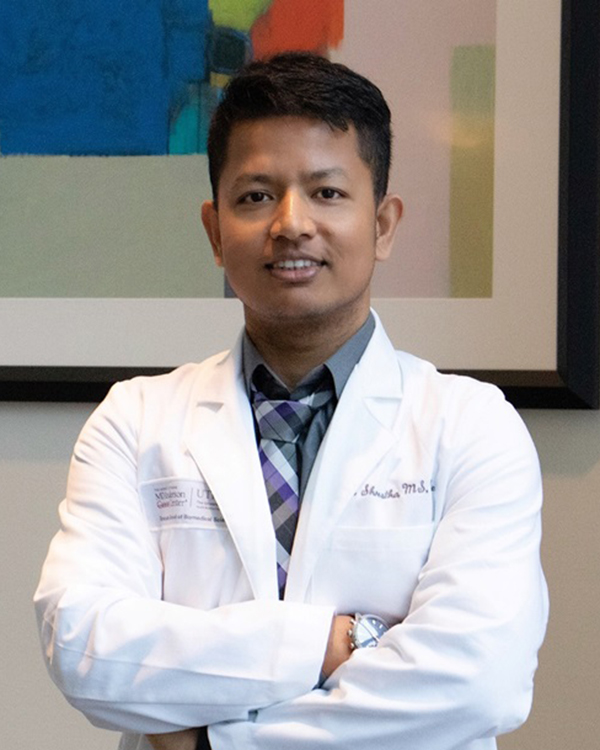News Archive
Deepesh Poudel, PhD, CHP, Los Alamos National Laboratory

Suman Shrestha, in the George and Cynthia Mitchell Basic Sciences Research Building, the home for The MD Anderson UTHealth Graduate School of Biomedical Sciences at Houston.
Photo courtesy of Tracey Barnett
Continuing our efforts to recognize outstanding students and graduates in health physics, we present Suman Shrestha, who graduated in 2018 with a master’s degree in the Medical and Health Physics Program at Louisiana State University (LSU). He is the 2021 Robert S. Landauer Sr. Fellow of the Health Physics Society (HPS) and doctoral research fellow at the University of Texas MD Anderson Cancer Center UT Health Graduate School of Biomedical Sciences, USA.
Suman is pursuing his PhD in the Late-Effects Research Laboratory at MD Anderson Cancer Center, led by Prof. Dr. Rebecca M. Howell. The primary focus of this research group is radiation therapy-related late effects and quantifying relationships between radiation to specific organs and late effects in childhood cancer survivors. Such dose-response relationships can be used to establish dose limits for contemporary treatment planning to minimize risk in future survivors as well as inform surveillance practices for at-risk childhood cancer survivors. Suman serves as the co-investigator on multiple research projects supported by Childhood Cancer Survivor Study (CCSS). The focus of his PhD research is on developing models to predict the risk of radiation therapy-related late cardiovascular disease to prospectively optimize contemporary radiation therapy and reduce the risk of late cardiovascular disease.
Suman's recent publication outlined a generalized framework for developing Digital Imaging and Communications in Medicine (DICOM) image-based organ models with substructure definition for late-effects studies. Specifically, they have developed and validated the very first CT-anatomy-based age-scalable cardiac model with substructures for late-effects research. His research lab has successfully reconstructed doses for about 13,000 survivors in the CCSS Cohort, who received radiation therapy using this new cardiac model. They are currently evaluating the relationship between cardiac substructure radiation dose and the risk of late cardiac toxicities. Suman is about to begin the third phase of his PhD work focused on developing and validating new risk score algorithms to prospectively predict the risk of cardiovascular disease. He anticipates completing his doctoral studies by the summer of next year and plans to start a combined post-doctoral fellowship and medical physics residency in the summer of 2022.
Prior to starting his education and training at LSU in 2015, Suman graduated with an MS in physics from the Central Department of Physics, Tribhuvan University, Nepal, and served as faculty of physics in the National Institute of Science and Technology (NIST), Nepal. At LSU, he trained with senior professors like Drs. Wayne D. Newhauser, Kenneth P. Matthews, and Wei-Hsung Wang and developed a physics-based generalized analytical algorithm to predict out-of-field stray radiation from neutrons emitted during proton therapy treatments.
Suman has received recognition from different medical associations for his work in the form of fellowships and awards. His recent honors include the prestigious CCSS Career Development Award from St. Jude Children's Research Hospital, Expanding Horizons Award from the American Association of Physicists in Medicine (AAPM), Marilyn and Fredreick R. Lummis Jr. MD Fellowship, Sylvan Rodriguez Foundation Scholarship from UT Health, NCI-sponsored Fellowship from the National Cancer Institute, Best Radiation Physics Paper award from MD Anderson, Robert S. Landauer Sr. Fellowship from the HPS, and, most recently, 2021 ACR Medical Physics Graduate Scholarship from the American College of Radiology. He has also received multiple additional travel awards to present his research on the national and international stage and has won multiple oral and poster competitions.
Suman is actively involved in national and international organizations in different capacities. Importantly, he serves as the current chair of Working Group on Student and Trainee Research (WGSTR) in the AAPM and Working Group on Communications (WGC) in International Society of Radiation Epidemiology and Dosimetry (ISoRED).
Suman gives credit to his mentors for his success thus far. He is thankful for the mentorship, guidance, and training opportunities provided by all the distinguished mentors throughout his career. A physicist by training, Suman aims to become an independent researcher, licensed medical physicist, and tenured professor. Later in his career, he plans to contribute to healthcare reform in developing countries and is committed to producing the next generation of physicists and pediatric health scientists.




